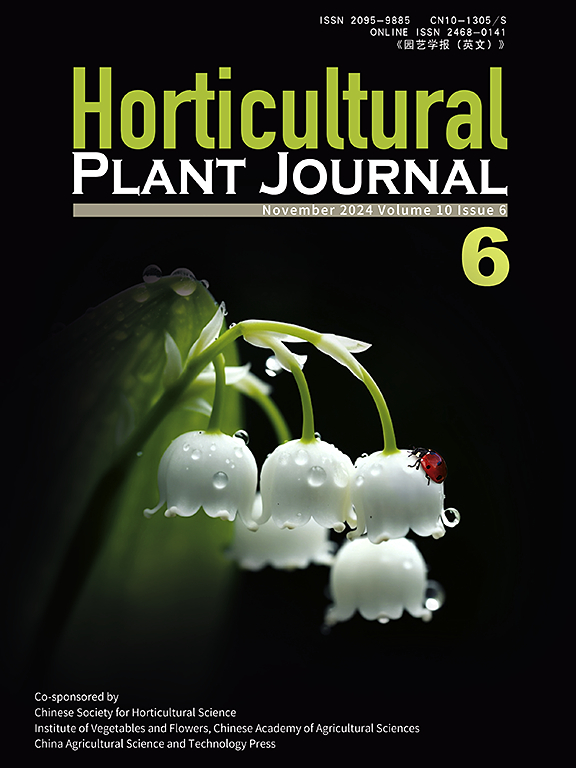代谢组学-转录组学分析揭示了增强UV-B辐射下“泰农1号”芒果果肉黄酮类化合物积累机制
IF 5.7
1区 农林科学
Q1 HORTICULTURE
引用次数: 0
摘要
芒果(Mangifera indica L.)是中国海南的主要经济作物之一,因其独特的风味和高营养价值而备受推崇。它还富含促进健康的抗氧化剂,如维生素C和类黄酮。增强的紫外线- b (UV-B)辐射,越来越受到全球环境的关注,改变了植物的抗氧化系统,增加了黄酮类化合物的积累作为一种常见的适应性反应。然而,它对芒果的影响在很大程度上仍未被探索。为了研究芒果对增强UV-B辐射的抗氧化反应,鉴定关键的类黄酮化合物和调控基因,我们将生长在自然光下的“泰农1号”芒果果实暴露在96 kJ·m-2·d-1的UV-B辐射下,模拟高UV-B环境。处理过的水果尺寸更小,果肉颜色更浓。此外,在果实快速膨大阶段,处理过的果实中丙二醛含量较高。此外,处理过的果实糖酸比、总酚、总黄酮、类胡萝卜素和抗坏血酸含量均有所增加。此外,通过FRAP、ABTS和DPPH检测,它们显示出显著增强的抗氧化活性。广泛的靶向代谢组学分析发现,黄酮类化合物是治疗组和对照组中差异表达的最大化合物类别。黄酮类化合物的定量代谢组学鉴定出金丝桃苷、槲皮素和(-)-儿茶素没食子酸酯是对UV-B处理反应的关键黄酮类化合物代谢产物。转录组分析显示,黄酮类生物合成途径富集,大多数相关差异表达基因表达上调。此外,qRT-PCR分析证实MiCHS7、MiCHI1、MiCHI2、MiFLS、MiF3H2和MiF3H3基因的表达与关键类黄酮代谢物的变化相关。相关分析表明,MiCHS7、MiCHI1、MiFLS和MiF3H3是参与UV-B处理下黄酮类化合物积累的潜在关键基因。因此,本研究为选育抗病性新品种和开发芒果抗uv - b栽培技术提供了理论依据。本文章由计算机程序翻译,如有差异,请以英文原文为准。
Metabolomic-Transcriptomic analysis unravels flavonoids accumulation mechanism in ‘Tainong 1’ mango pulp under enhanced UV-B radiation
Mango (Mangifera indica L.) is one of the main economic crops in Hainan, China, prized for its distinctive flavor and high nutritional value. It is also rich in health-promoting antioxidants such as vitamin C and flavonoids. Enhanced ultraviolet-B (UV-B) radiation, a growing global environmental concern, alters plant antioxidant systems, with increased flavonoid accumulation as a common adaptive response. However, its effects on mango fruit remain largely unexplored. To investigate the antioxidant responses of mango to enhanced UV-B radiation and identify key responsive flavonoid compounds and regulatory genes, we exposed ‘Tainong 1’ mango fruits growing under natural light to 96 kJ · m-2 · d-1 of UV-B radiation to simulate high UV-B conditions. Treated fruits were smaller in size and had a pulp of a more intense yellow colour. Further, malondialdehyde content in treated fruits was higher during the phase of rapid fruit enlargement. Additionally, treated fruits showed increased sugar-acid ratios, total phenol, total flavonoid, carotenoid, and ascorbic acid contents. Furthermore, they showed significantly enhanced antioxidant activity, as measured by the FRAP, ABTS, and DPPH assays. Extensive targeted metabolomic-analysis identified flavonoids as the largest category of compounds differentially expressed in treated and control groups. Quantitative metabolomics of flavonoids identified Hyperoside, Quercimeritrin, and (-)-Catechin gallate as the key flavonoid metabolites responsive to UV-B treatment. Transcriptome analysis revealed an enrichment of the flavonoid biosynthesis pathway, with most associated differentially expressed genes showing upregulation. Furthermore, qRT-PCR analysis confirmed that the expression of the genes MiCHS7 , MiCHI1 , MiCHI2 , MiFLS , MiF3H2 , and MiF3H3 correlated with changes in key flavonoid metabolites. Indeed, correlation analysis indicated that MiCHS7 , MiCHI1 , MiFLS , and MiF3H3 are potential key genes involved in flavonoid accumulation under UV-B treatment. Thus, our study provides a theoretical basis for breeding for new resilient varieties and developing UV-B-resistant mango cultivation techniques.
求助全文
通过发布文献求助,成功后即可免费获取论文全文。
去求助
来源期刊

Horticultural Plant Journal
Environmental Science-Ecology
CiteScore
9.60
自引率
14.00%
发文量
293
审稿时长
33 weeks
期刊介绍:
Horticultural Plant Journal (HPJ) is an OPEN ACCESS international journal. HPJ publishes research related to all horticultural plants, including fruits, vegetables, ornamental plants, tea plants, and medicinal plants, etc. The journal covers all aspects of horticultural crop sciences, including germplasm resources, genetics and breeding, tillage and cultivation, physiology and biochemistry, ecology, genomics, biotechnology, plant protection, postharvest processing, etc. Article types include Original research papers, Reviews, and Short communications.
 求助内容:
求助内容: 应助结果提醒方式:
应助结果提醒方式:


